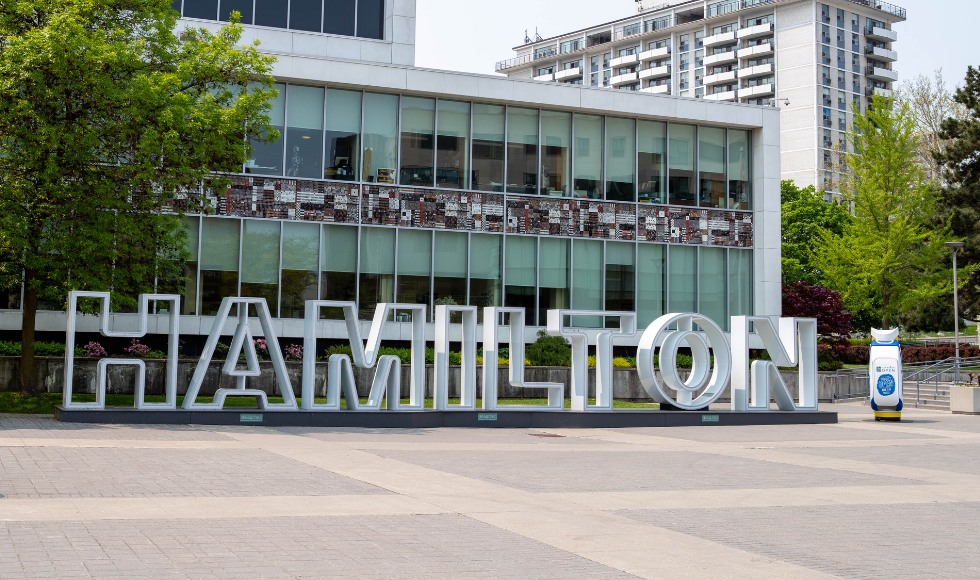IBH students tackle real-life challenges for community organizations

Integrated Business and Humanities (IBH) students worked with community organizations in Hamilton and Guelph, tackling real-life challenges as part of their senior capstone course in community engagement. (Photo by Georgia Kirkos/McMaster University).
The Integrated Business and Humanities (IBH) program was designed to create a different kind of business leader, says Karen Balcom, an associate professor of history/gender & social justice.

“The idea […] was to try to deeply blend the communication, critical thinking and orientation to social justice and social change from a humanities education with business skills,” says Balcom, who is the academic co-director for teaching and learning in the Office of Community Engagement.
This blending of skills culminates in a final year senior capstone project where students work with community organizations, taking on real-life scenarios and challenges.
Balcom says it was great to see the first full graduating cohort from the program (which is jointly offered by the DeGroote School of Business and the Faculty of Humanities), apply the advanced skills they acquired in the classroom to experiential community-based work this past term.
Eight teams of students worked across several organizations in Hamilton as part of the Capstone in Community Engagement course under Balcom’s direction. Here are three of the projects that students completed:
Hamilton Community Foundation
A total of seventeen students worked in partnership with the Hamilton Community Foundation (HCF) to create a report that will help inform the foundation’s institutional policy and practices with respect to divestment from fossil fuels.
Three teams — one studying practices other institutions have adopted, one looking at the sociological implications for Hamilton and the other studying the financial and business implications of the move — compiled their findings into a report that was presented to the HCF.
“The real hands-on experience from this course is completely different than any other undergraduate class,” says Davis Kempster, one of the students who helped create the final report.
“You are facilitating meaningful work – work that will actually have a real impact on an organization and ultimately the surrounding Hamilton community.”
10C Shared Space
Students worked with 10C Shared Space, a community hub and shared workspace in Guelph, Ontario to support the non-profit’s communications efforts.
They also created case entries, detailing how 10C had used innovative social financing models like community bonds to create capital to build spaces for change — both physically and metaphorically.
These case entries now live on the McMaster-based Participedia.net, the world’s largest crowdsourced database aimed at sharing knowledge and generating research related to democratic innovations.
Rachel West, who worked as a student with 10C over the course of the term, says she is happy these resources now exist for other organizations looking to enact social change.
“Many social enterprises are very small and lack resources and mentorship opportunities,” says West.
“I think Participedia is an amazing platform that can enable like-minded individuals from organizations like 10C to find one another and seek out valuable connections within their space of knowledge.”
CityHousing Hamilton
For their capstone project, a group of students — as part of an existing CityLab collaboration with CityHousing Hamilton — investigated non-police security measures for the social housing provider.
Students conducted a general literature review to examine more communitarian models of providing policing and conducted interviews with officials from housing organizations in other cities that have moved towards that communitarian model.
“Our goal was to give CityHousing different options and perspectives on safety to allow the organization to assess what approach would be the most effective for its residents. I believe that we achieved this goal successfully and have provided CityHousing with the tools it needs to make informed decisions and move forward with a revised plan,” says Nicole Harris, who worked as a student on the project.
“At the same time, I think that it is also important to recognize that, while our team worked very hard to address CityHousing’s research questions, our final deliverables are just the start of what is needed to solve the issue of community safety.”
Emily Scherzinger helped Balcom develop the course as a research assistant. Scherzinger, now a postdoctoral fellow at the McMaster Child and Youth University, says she is incredibly proud of the work the students completed.
The students “produced some amazing and relevant work that is financially sustainable but refracted through the important lenses of social justice, reflexive practices and community care,” says Scherzinger.
Balcom stresses, “the success of these projects — and indeed of all initiatives in community-engaged teaching and learning — depends on building respectful, sustained and mutually beneficial relationships with our community partners. We are very appreciative of the support of our partners for their willingness to work with our students.”
Balcom says the course was supported by the staff in the Office of Community Engagement and is an example of the interdisciplinary and community-engaged education that has been championed by Kim Dej, vice-provost, Teaching and Learning.
“I think this kind of learning really empowers students and shows them how their knowledge can work in the world,” says Balcom.
Resources for instructors considering community-engaged teaching and learning can be found here. The Office of Community Engagement can be reached at community@mcmaster.ca.

